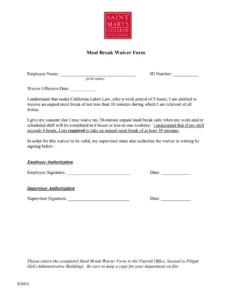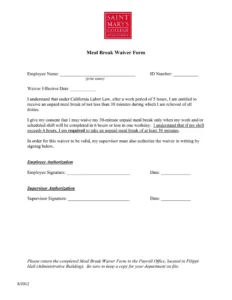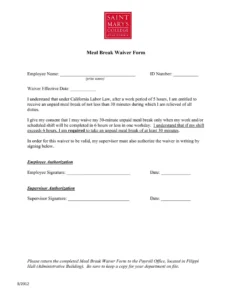Utilizing a pre-designed structure for these waivers provides legal protection for both employers and employees. It ensures compliance with labor laws by clearly documenting the agreement, mitigating potential disputes and misunderstandings. This documentation can also streamline record-keeping and simplify internal processes. For employees, a clear written agreement offers assurance that their decision is formally recognized and understood.
Understanding the components and purpose of these forms is essential for both employers and employees. The following sections delve into the legal considerations, best practices, and potential implications related to waiving meal breaks.

Key Components of a Meal Break Waiver
Several crucial elements ensure a legally sound and mutually beneficial agreement regarding waived meal periods.
1: Employee Identification: Clear identification of the employee waiving the meal break, including their full name and employee ID.
2: Date and Time of Waiver: Specific date and time the waiver applies to, preventing ambiguity about the waiver’s duration.
3: Specific Meal Period Waived: Precise designation of the meal period being waived, ensuring clarity about which break is affected.
4: Voluntary Waiver Confirmation: Explicit statement confirming the employee’s voluntary agreement to waive the meal break, protecting against claims of coercion.
5: Explanation of Rights: A clear explanation of the employee’s legal right to a meal break, reinforcing that the waiver is a choice, not a requirement.
6: Employer Compliance Statement: An assertion that the employer understands and complies with applicable labor laws regarding meal break waivers, demonstrating commitment to legal compliance.
7: Signatures: Spaces for both employee and employer (or authorized representative) signatures, formalizing the agreement and indicating mutual understanding.
These components work together to establish a robust and legally compliant document that safeguards the interests of both parties while ensuring clarity and transparency.
How to Create a Meal Break Waiver Agreement Template
Creating a robust template ensures clarity, legality, and protects the interests of all parties involved. A well-drafted template facilitates consistent application and streamlines the waiver process.
1: Consult Legal Counsel: Legal review is crucial to ensure compliance with specific state and federal regulations governing meal breaks and waivers. This safeguards against potential legal challenges and ensures the document’s enforceability.
2: Clearly Define the Scope: Specify the situations where the template will be used. Defining the scope helps maintain consistency and clarifies the purpose of the waiver.
3: Include Essential Elements: Incorporate the key components previously outlined, such as employee identification, date and time, specific meal period, voluntary confirmation, explanation of rights, employer compliance statement, and signature lines. These elements ensure a comprehensive and legally sound agreement.
4: Use Clear and Concise Language: Employ straightforward language easily understood by all parties. Avoid jargon and technical terms that may create confusion. Clarity promotes understanding and reduces the likelihood of misinterpretation.
5: Establish a Retention Policy: Determine how long waivers will be kept on file and ensure secure storage. This facilitates easy retrieval if needed for compliance or audit purposes.
6: Training and Communication: Provide training to managers and employees on the proper use of the template and the implications of waiving a meal break. Clear communication fosters transparency and informed decision-making.
A thoughtfully designed template, incorporating these steps, safeguards legal compliance, promotes clarity, and ensures a fair and transparent process for all stakeholders.
Proper implementation of legally sound, clearly defined meal break waiver agreements provides crucial protection for both employers and employees. Standardized templates ensure compliance with labor laws, minimize potential disputes, and streamline record-keeping processes. Careful attention to essential components, legal review, and transparent communication are vital for successful implementation. Understanding the implications and responsibilities associated with these agreements contributes to a fair and compliant workplace environment.
Organizations are encouraged to prioritize the development and implementation of comprehensive meal break waiver agreement templates. Proactive measures in this area demonstrate a commitment to legal compliance, employee well-being, and a positive work environment. Regular review and updates of these templates, in accordance with evolving legal landscapes and best practices, are essential for maintaining a robust and ethical framework.



